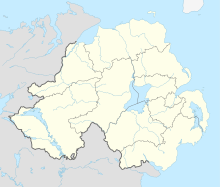RAF Nutts Corner
|
RAF Nutts Corner |
|||||||||||||||||||
|---|---|---|---|---|---|---|---|---|---|---|---|---|---|---|---|---|---|---|---|
| Summary | |||||||||||||||||||
| Airport type | Military | ||||||||||||||||||
| Owner | Air Ministry | ||||||||||||||||||
| Operator | Royal Air Force | ||||||||||||||||||
| Location | Crumlin, County Antrim | ||||||||||||||||||
| Built | 1939 | ||||||||||||||||||
| In use | 1939-1946 | ||||||||||||||||||
| Elevation AMSL | 315 ft / 96 m | ||||||||||||||||||
| Coordinates | 54°37′52″N 006°09′14″W / 54.63111°N 6.15389°WCoordinates: 54°37′52″N 006°09′14″W / 54.63111°N 6.15389°W | ||||||||||||||||||
| Map | |||||||||||||||||||
| Location in Northern Ireland | |||||||||||||||||||
| Runways | |||||||||||||||||||
|
|||||||||||||||||||
RAF Nutts Corner is a former Royal Air Force station located 2.7 miles (4.3 km) east of Crumlin, County Antrim, Northern Ireland and 9.2 miles (14.8 km) north west of Belfast.
It was originally a civil airfield, then it became a military airfield and subsequently Northern Ireland's main civil airport until the 1960s.
Civil flights began around 1920 from Aldergrove, what is now Belfast International Airport, approximately 3.3 miles (5.3 km) away from Nutts Corner. The province's first London service began from Nutts Corner in 1934.
Civil operations were largely abandoned at both Nutts Corner and RAF Aldergrove during the Second World War when it became an important RAF Coastal Command station and was also used as a transport hub for aircraft arriving from the United States. No. 120 Squadron RAF operated Consolidated Liberator maritime patrol bombers from the station from 1941.
In 1946 civil air operations were transferred from Belfast Harbour Airport (now the George Best Belfast City Airport) to RAF Nutts Corner due to the longer runways available at that airfield. Other reasons included the limited space available at Belfast for expansion and the danger associated with obstacles such as the cranes around Belfast harbour. Other sites were studied as possible alternative civil airports including RAF Long Kesh and Lisburn. The advantage of choosing Nutts Corner was the large amount of existing hardstanding which was necessary for civil aircraft movements. The former RAF station then became known as Belfast-Nutts Corner Airport.
By the end of the 1950s the steep approach necessary for aircraft flying to Nutts Corner was deemed unsuitable. This was due to the location of the airport, close to the Belfast mountains and the obstacles located there, particularly transmitters and aerials. Another factor was the fact that of Nutts Corner's three runways, only one was suitable for modern aircraft. Aldergrove's two runways set at 100 degrees (07-25 and 17-35) to each other made operations possible even if conditions (particularly wind) changed dramatically. The decision to restore civil flights to Aldergrove was taken in July 1959. The move was made official in September 1963 and a month later the present terminal was opened.
...
Wikipedia

